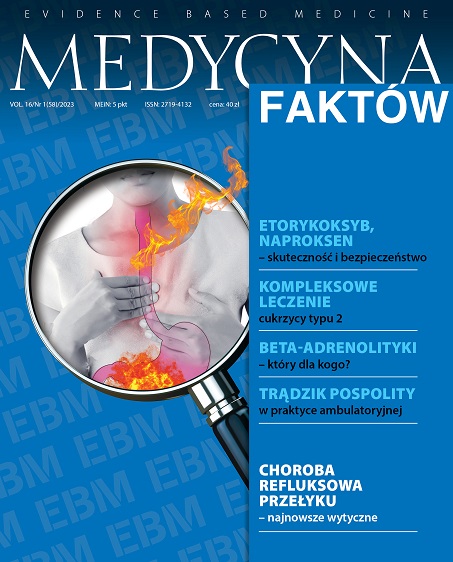Esophageal and extraesophageal symptoms of gastroesophageal reflux disease – the management according to the recent recommendations Review article
Main Article Content
Abstract
Gastroesophageal reflux disease is one of the most common disease of the upper gastrointestinal tract. Current researches shows, it affects about 20–23% of the adult population in Western Europe and North America. The biggest challenges and problems in treatment of gastroesophageal reflux disease are: atypical symptoms, extraesophageal symptoms and drug resistance, mainly proton pump inhibitors, which are basic group of drugs in this indication. The lack of effectiveness of proton pump inhibitors affects 17–45% of patients. If despite proton pump inhibitors treatment symptoms persist, it is possible to double the dose of proton pump inhibitor or replace it with another proton pump inhibitor, or add an H2 receptor blocker, alginate, sucralfate or a prokinetic drug. Recently, there have been published new recommendations with main aim to increase the effectiveness of therapy. In 2021, combined European and American guidelines for the management of treatment-resistant reflux disease were published, and in 2022, the Polish Society of Gastroenterology published guidelines for the treatment of reflux disease. The paper summarizes the most important issues of above documents.
Article Details
Copyright © by Medical Education. All rights reserved.
References
2. Ziółkowski BA, Pacholec A, Kudlicka M et al. Prevalence of abdominal symptoms in the Polish population. Prz Gastroenterol. 2012; 7: 20-5.
3. Vakil N, van Zanten SV, Kahrilas P et al. The Montreal definition and classification of gastroesophageal reflux disease: a global evidence based on the consensus. Am J Gastroenterol. 2006; 101: S1-S16.
4. Lovell RM, Ford AC. Prevalence of gastro-esophageal reflux type symptoms in individuals with irritable bowel syndrome in the community: a meta-analysis. Am J Gastroenterol. 2012; 107: 1793-801.
5. de Bortoli N, Martinucci I, Bellini M et al. Overlap of functional heartburn and gastroesophageal reflux disease with irritable bowel syndrome. World J Gastroenterol. 2013; 19: 5787-97.
6. Gąsiorowska A, Janiak M, Waśko-Czopnik D et al. Postępowanie u pacjentów z objawami choroby refluksowej przełyku – rekomendacje dla lekarzy rodzinnych. Lekarz POZ. 2019; 3/4: 245-65.
7. Kahrilas P, Shaheen NJ, Vaezi MF. American Gastroenterological Association Institute technical review on the management of gastroesophageal reflux disease. Gastroenterology. 2008; 135: 1392-413.
8. Katz PO, Gerson LB, Vela M. Guidelines for the diagnosis and management of gastroesophageal reflux disease. Am J Gastroenterol. 2013; 108: 308-28.
9. Moore JM, Vaezi MF. Extraesophageal manifestations of gastroesophageal reflux disease: real or imagined? Current Opin Gastroenterol. 2010; 26: 389-94.
10. Vaezi MF. Therapy insight: gatroesophageal reflux disease and laryngopharyngeal reflux. Nat Clin Pract Gastroenterol Hepatol. 2005; 2: 595-603.
11. Iwakiri K, Kinoshita Y, Habu Y et al. Evidence-based clinical practice guidelines for gastroesophageal reflux disease 2015. Am J Gastroenterol. 2016; 51: 751-67.
12. Gyawali CP, Kahrilas PJ, Savarino E. Modern diagnosis of GERD: the Lyon Consensus. Gut. 2018; 67: 1351-62.
13. Sifrim D, Zerbib F. Diagnosis and management of patients with reflux symptoms refractory to proton pump inhibitors. Gut. 2012; 61: 1340-54.
14. Gyawali CP, Fass R. Management of Gastroesophageal Reflux Disease. Gastroenterology. 2018; 154: 302-18.
15. Spechler SJ, Sharma P, Souza RF et al. Association AG. American Gastroenterological Association medical position statement on the management of Barrett’s esophagus. Gastroenterology. 2011; 140: 1084-91.
16. Shaheen NJ, Falk GW, Iyer PG et al. ACG Clinical Guideline: Diagnosis and Management of Barrett’s esophagus. Am J Gastroenterol. 2016; 111: 30-50.
17. Vaezi MF, Pandolfino JE, Vela MF et al. White paper AGA: Optimal strategies to define and diagnose gastroesophageal reflux disease. Clin Gastroenterol Hepatol. 2017; 15: 1162-72.
18. Savarino E, Zentilin P, Mastracci L et al. Microscopic esophagitis distinguishes patients with non-erosive reflux disease from those with functional heartburn. J Gastroenterol. 2013; 48: 473-82.
19. Trudgill NJ. British Society of Gastroenterology guidelines for esophageal manometry and esophageal reflux monitoring. Gut. 2019; 66: 1-20.
20. Mittal R, Vaezi MF. Esophageal motility disorders and gastroesophageal reflux disease. N Engl J Med. 2020; 383: 1961-72.
21. Vaezi MF, Pandolfino JE, Yadlapati RH et al. ACG guidelines: diagnosis and management of achalasia. Am J Gastroenterol. 2020; 115: 1393-411.
22. Vaezi MF, Sifrim D. Assessing old and new diagnostic tests for gastroesophageal reflux disease. Gastroenterology. 2018; 154: 289-301.
23. Saleh CM, Smout AJ, Bredenoord AJ. The diagnostic of gastro-esophageal reflux disease cannot be made with barium esophagograms. Neurogastroenterol Motil. 2015; 27: 195-200.
24. Katzka DA, Pandolfino JE, Kahrilas PJ. Phenotypes of gastroesophageal reflux disease: Where Rome, Lyon and Montreal meet. Clin Gastroenterol Hepatol. 2019; 2: 24-35.
25. Boeckxstaens G, El-Serag HM, Smout A et al. Symptomatic reflux disease: the present, the past and the future. Gut. 2014; 63(7): 1185-93.
26. Mahoney LB, Rosen R. The spectrum of reflux phenotypes. Gastroenterol Hepatol. 2019; 15(12): 646-54.
27. Gąsiorowska A. Ochrona i regeneracja błony śluzowej przełyku, gardła i krtani jako ważny element terapii u pacjentów z przełykowymi i pozaprzełykowymi objawami choroby refluksowej. Otolaryngol Pol. 2020; 74(4): 40-5.
28. Haastrup PF, Thompson W, Sondegaard J et al. Side effects of long-term proton pump inhibitor use: a review. Basic Clin Pharmacol Toxicol. 2018; 123: 114-22.

